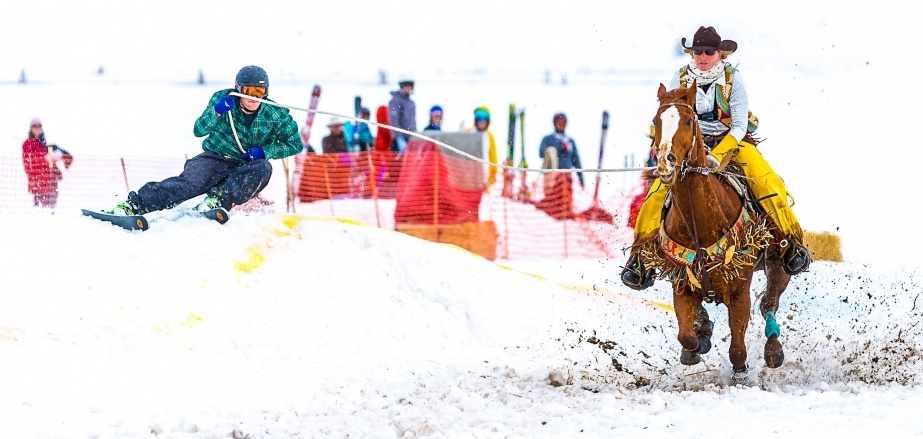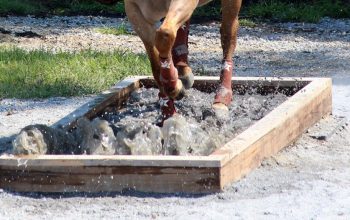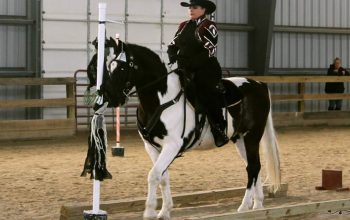By Loren Zhimanskova
Photgraphy by Mark LaRowe
Visually, everyone is drawn to the beautiful sight of a horse running in snow, mane flying. Add the surprise element of a skier carving turns or catching air behind this powerful creature, and the image becomes even more compelling. Add riders dressed in wooly chaps, cowboy hats and fringed leather coats and skiers sporting vintage sweaters and retro one-piece ski suits and POW! A unique brand is born.

Mark LaRowe was drawn to the sport of skijoring five years ago when he decided to pursue photography as a full-time profession. Just like the sport, his journey has been anything but conventional. It was in Jackson Hole, Wyoming at a skijoring race at the Melody Ranch one cold February day in 2014, that he crossed paths with Loren Zhimanskova, an art historian, who was fascinated by the sport from a historical perspective. As the saying goes, “The rest is history.”
“We are building on an American tradition over a century old and modernizing it without sacrificing its roots and rich, colorful history”
Mark and Loren are now both entrenched in the sport and together head up the organization, Skijor USA, which is restructuring and rebranding equine skijoring through a dynamic, fresh approach. “We are building on an American tradition over a century old and modernizing it without sacrificing its roots and rich, colorful history,” Zhimanskova says. Skijoring made its first appearance over 100 years ago in the United States. As early as 1915, the Lake Placid Resort offered it as a recreational activity to guests. Around the same time, Dartmouth College and Steamboat Springs, Colorado began to include skijoring races in their annual Winter Carnivals.

Skijor USA’s races trace the spine of the Rocky Mountains and attract competitors from Montana, Wyoming, Colorado, New Mexico, Idaho, Utah, South Dakota, California and Minnesota. The events are marketed under the name Triple Cross. Horse, Rider, Skier. Gates, Jumps, Rings. Rebranding is part of the process of promoting this unusual sport, just as Mark
LaRowe is rebranding himself professionally. “Photography has provided me with a new avenue for personal growth, professional development and creative evolution. I’ve always loved the American West since I was a child growing up in Wisconsin. It is now a privilege to be living here and being able to photograph the landscapes, people and events I grew up admiring.“
A 1991 graduate of the University of Wisconsin-Madison in Natural Resource Management, Mark embarked on a successful 25-year career in the environmental construction and remediation industry, but in early 2016 he moved into a small log cabin north of Helena, MT trading his Delta Airlines Diamond status for a pick-up truck. Now, as a corporate partner and official photographer for the Billings, MT-based Northern Rodeo Association (NRA), Mark packs his camera gear around instead of a brief case following the NRA circuit all summer. He also photographs western landscapes, ranch life and offers portraiture and wedding photography.
In the winter months, however, it is skijoring that dominates his schedule as the official photographer for Skijor USA and its 12-week race circuit. The tapestry of characters involved in the sport, the variety of horses which compete, the small towns and communities which host races and the changing weather conditions offer Mark an infinite number of subjects and variables. Building relationships with competitors and organizers is also key to gain access and build trust on the track, and, lately, Mark has been studying more than camera angles at events.

For example, Skijor USA is the first organization to ask competitors to nominate teams and qualify within regions to vie for a title at a year-end National Championship Final in West Yellowstone, Montana. In 2019, Skijor USA also introduced a 3D race format using time splits to determine divisions and placements much like barrel racing. “Consistency, fairness and safety are paramount in order for the sport to grow and thrive,” Zhimanskova and LaRowe agree.

Many ask, what makes a great skijoring horse? Richard Raymer of Saratoga, Wyoming says his #1 criteria for a skijoring horse is control. “You can have the fastest horse around, but if you can’t get him to the start, it does no good.” #2 is manners, and #3 is speed. Richard recently bought a horse named Cage that fits the bill perfectly, but he is also about to train two three year old mustangs this summer!
Corie Downey of Whitehall, Montana says trust is number one. Then heart. Then confirmation. She believes if you have all three of these, speed will come, but “MOST IMPORTANTLY, trust has to go both ways.” Similarly, Dan Eckert of Wolcott, Colorado says, “The rider’s ability must match that of the horse, and they must communicate well.” Find a strong skier who works well behind the horse and rider, and you have a winning combination!
For more information on Skijor USA, go to www.skijorusa.com and for information on the global history of skijoring go to www.skijorinternational.com.
To view Mark LaRowe’s work, go to www.marklarowe.photoshelter.com





